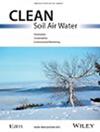Waste Materials for the Phosphorus Adsorption Study
Abstract
Using waste materials as adsorbents helps in attaining the goal of the circular economy for sustainable environmental development. Numerous wastes have undergone testing for their potential for the adsorption of contaminants and toxicants. The motive of the presented work was to appraise the phosphorus (P) adsorption capacities and physicochemical characteristics of brick and tile waste for use as a substrate in the constructed wetlands (CWs). The data showed that the P adsorption capacity for materials increased with the initial concentration. The nonlinear regression analysis of the experimental data revealed that the Langmuir isotherm was more suitable for the brick waste and tile waste study. For brick waste, the maximum adsorption was 1.86 mg/g, and for tile waste, it was 0.65 mg/g. The P adsorption capacity of both materials was reduced in batch studies with domestic wastewater. The increase in pH of the solution greatly reduced the adsorption capacity of brick waste, whereas the reduction was marginal for tile waste. The microstructure of both materials showed the presence of pores on the uneven surface, which increased the specific surface area and facilitated adsorption. The ability of both materials to adsorb in column studies was less compared to the Langmuir isotherm adsorption value due to the dynamic environment setting. Both materials showed the potential for use as substrates in the CW for the elimination of P.


 求助内容:
求助内容: 应助结果提醒方式:
应助结果提醒方式:


